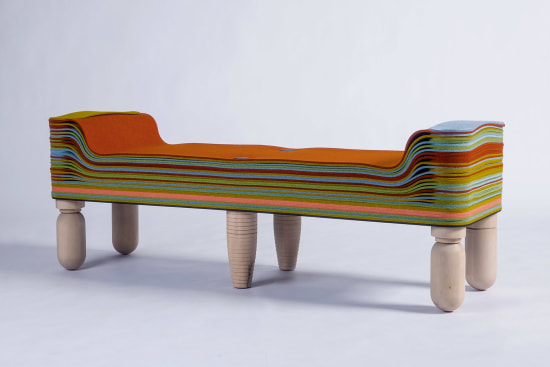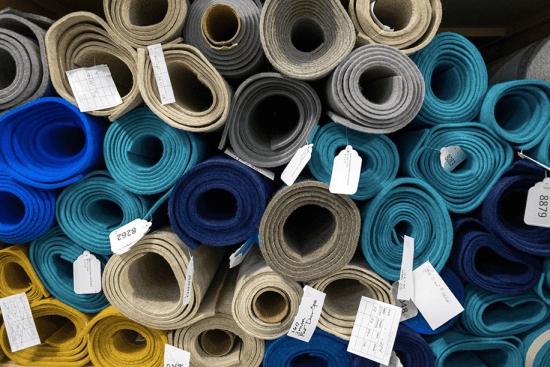
Photos of felt offcuts by Patrick Biller, courtesy STACKABL.
STACKABL
Creative reuse has shaped culture for centuries. From the rich heritage of antique collecting to recent innovations in recycling technology, reimagining what’s possible with what’s already there presents an exciting challenge to the design community. It is this shared passion that lies at the heart of STACKABL.
Put simply, STACKABL is a new configurator that anyone can operate to design furniture online—an innovative system that allows you to turn high quality offcuts from regional manufacturers into fully finished, custom work ready to be shipped to your home or project.
How it Works
The configurator's real-time visualizations in 2D and 3D enable you, the designer, to see your choices of colors, patterns, dimensions, and densities come to life (and to view instant pricing feedback as you go).

What the configurator looks like. First you pick your type of design, then you customize your piece.
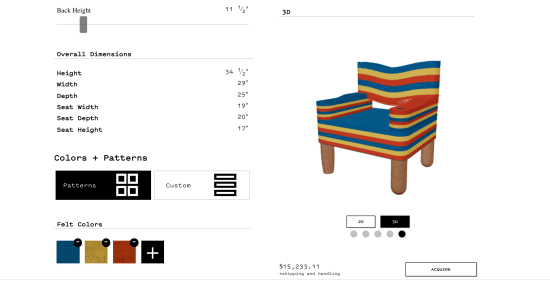
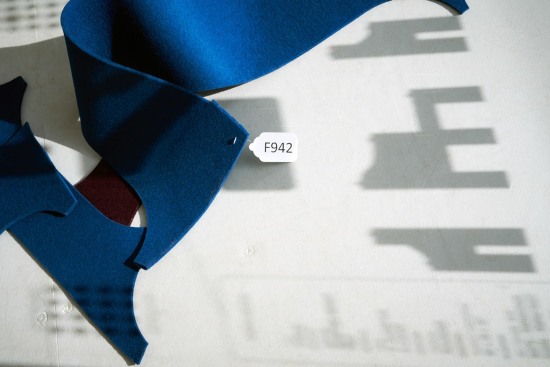
Developed closely with regional manufacturers, and aided by algorithms and robotics, the configurator identifies remnant inventory (in the form of metal, wood, and felt) that fits your aesthetic choices. This inventory is then put back through the manufacturers' own machines, and into the hands of their own experts, who execute the design.
At the end of this intuitive and transparent experience is the piece you've created, ready for its new home. And by using existing regional resources, you've empowered local economies while curbing everyone's carbon footprint.
To create your very own design in the configurator, visit https://www.stackabl.shop/types
Maison Gerard and STACKABL
To introduce this incredible new configurator to the world, Maison Gerard and STACKABL decided to team up. Tapping the talents of six prominent designers, Maison Gerard asked them to create pieces of their own within STACKABL.
With no brief to draw from, other than to work within the parameters set by the configurator, the designers — Alexandra Champalimaud, Drake / Anderson, Elena Frampton, Georgis & Mirgorodsky, Laura Kirar, and Benoist F. Drut — were free to realize their own visions. The result is a striking array of characterful works that belong to both past and future.
Pulling from a vast range of historical, contemporary, and personal references, from Louis XVI to Brad Davis and many more unlikely muses in-between, this body of work demonstrates the endless possibilities at the intersection of design, technology and circular manufacturing, where the imagination takes hold.
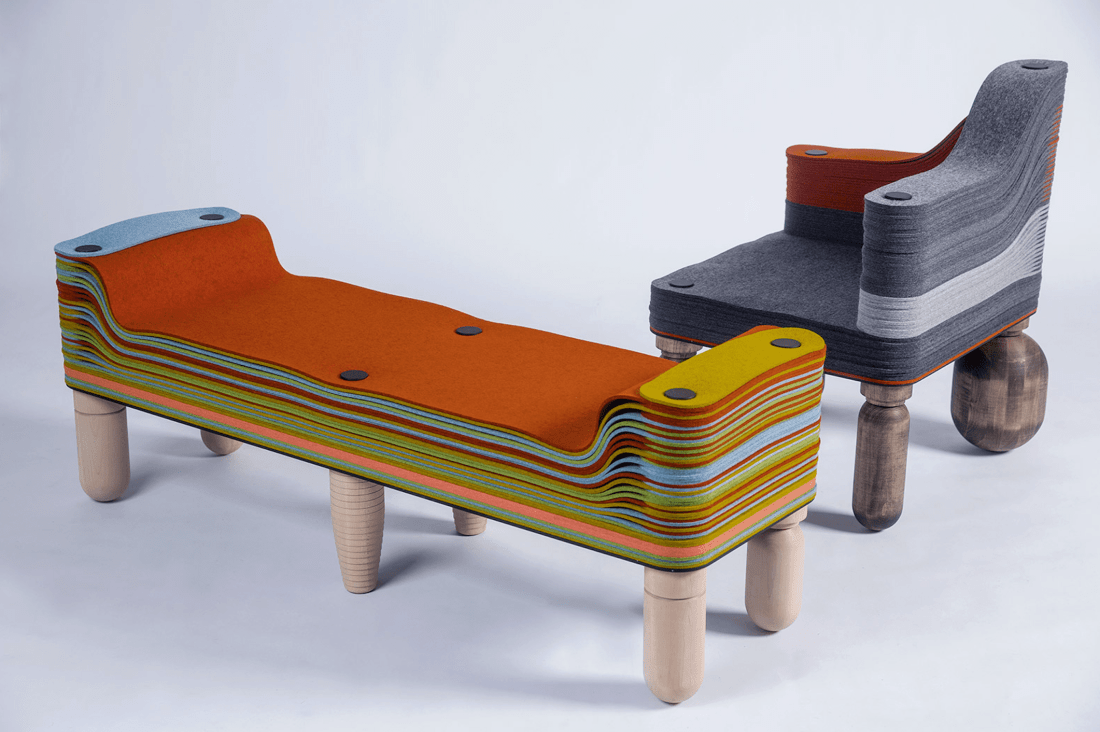
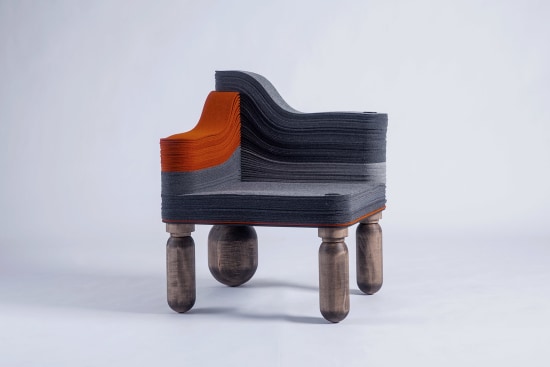
Raki, A Corner Chair by Alexandra Champalimaud
With a big character and a huge heart, this joyful corner chair is inspired by a dear family pet who brings an abundance of fun and whimsy wherever he goes. Raki is a humorous play on perspectives, offering new forms and conveying movement from every angle; the result of the designer’s fondness for “twirling it around” as a 3D render within the configurator. Embodying the spirit of the process is the contrasting back leg, whose curvy and sturdy form peeks out from underneath layers of graphite and rust, while the seat itself welcomes you with open arms. The resulting design is an intuitive, happy experiment in color, form, and materiality, effortlessly filling a generous interior with life and soul. (Click anywhere on the text to follow a link to the work's page on our website).
Madame, A Chaise Lounge by Jamie Drake & Caleb Anderson
Named after Madame Récamier, the 19th-century French socialite noted for her extreme beauty and intellectual prowess as well as her salon, which drew literary and political luminaries of the time, this Modernist take on the chaise lounge invites conversation and stimulates thought. Its crimson hue and sloping shoulders recall the sensuality of neoclassical portraiture, while the slice of shocking pink lending a piquant contrast at the base is an ode to another famous Madame, Elsa Schiaparelli, the provocative fashion designer who popularized the bright shade in her 1940s couture creations. This bold, beautiful homage to two of history’s most alluring women would sit comfortably in any bedroom, or as a pair either side of a fireplace in opposing directions, to spark a tantalizing tête-à-tête. (Click anywhere on the text to follow a link to the piece's page on our website).
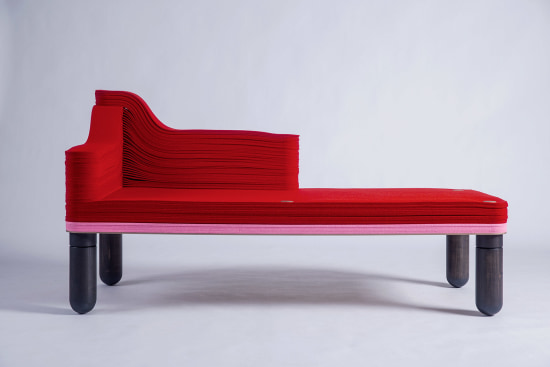

Fast Lane, An Armchair by Elena Frampton
Inspired by racing stripes and informed by a childhood immersed in L.A.’s car culture, Fast Lane expertly combines elegance and energy in equal measure. Designed in response to seasonal shifts, this sophisticated reimagining of the classic lounge chair showcases the celebrated designer’s eye for the unexpected. While its blue stripes and generous proportions recall beach house glamour, it’s the hot pink streak running through the middle of the seat that reveals its fun side. There’s more, too: look closer and you’ll notice one of the legs curves differently from the others. Consider pairing this captivating chair with Matthew Porter’s flying muscle car photography series for a true celebration of the nostalgia and romance of the car in American culture. (Click anywhere on the text to follow a link to the work's page on our website).
Querelle, A Club Chair by Georgis & Mirgorodsky
After an initial attempt to defy the configurator and get around its set limitations, Georgis & Mirgorodsky allowed themselves to completely submit to its demands and play along. They discovered that embracing its constraints sparked their imagination in new and unexpected ways, allowing them to overlay unintended meaning onto the object and imbue it with a piece of each of themselves. The nautical stripe effect immediately led them to Querelle, the handsome Belgian sailor and queer cinema icon at the center of Rainer Werner Fassbinder’s 1982 arthouse film. Based on the book by Jean Genet, the story is set in a French port town where sex, drugs and violence collide with our unlikely hero’s quest for identity. This commanding club chair brings undeniable sex appeal and presence to its environment. (Click anywhere on the text to follow a link to the work's page on our website).
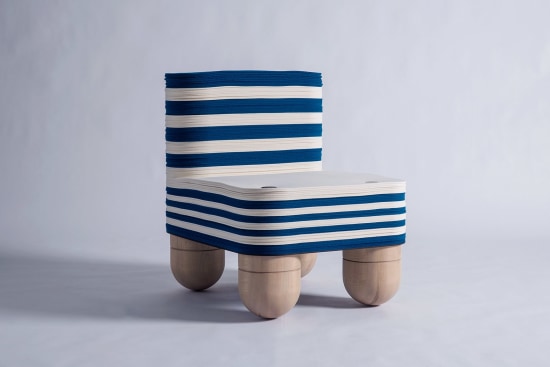
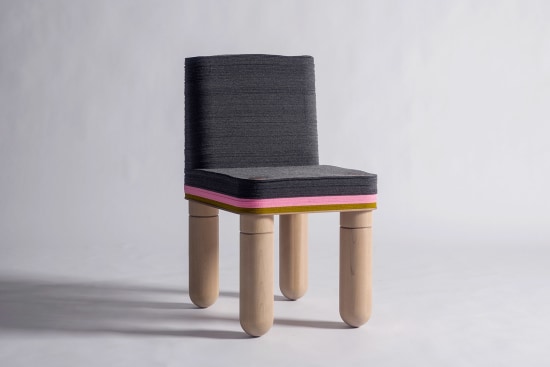
Dulces, A Dining Chair by Laura Kirar
Since moving to Mexico four years ago, Laura Kirar has radically changed her perspective on color. Her new appreciation for brighter shades comes through in Dulces, which means ‘candies.’ Her chosen color configuration is a little something sweet to bring joy and flavor to the dining table. Embracing the geometric forms generated by the configurator, she layered in the material and color according to her typical process. Through ochre finishes and a hot pink accent, she evokes the colors of the local climate and culture, such as the work of the influential architect Luis Barragán, to arrive at a piece that is at once simple and striking enough to sweeten a variety of interiors, and bring its sunny disposition to any dinner party. (Click anywhere on the text to follow a link to the work's page on our website).
Maxine, A Bench by Benoist F. Drut
Drut’s eye for eclecticism and exuberance is palpable in his design for the Maxine bench. The artistry and symmetry of eighteenth-century French royal furnishings, the energy and expertise of Parisian gallerist/decorator Madeleine Castaing, the Orientalist architecture of Frederic Church’s historical Hudson Valley home, and the impeccable style of 1950s English model, actress and designer Maxime de la Falaise (née Maxine Bailly) are just a few the historical references that make this bench the perfect conversation piece. Effortlessly blending neoclassical lines with whimsical flourishes, Maxine sees Drut bringing his own, distinct flair to a beloved heritage. (Click anywhere on the text to follow a link to the work's page on our website).
